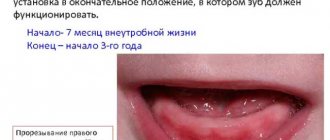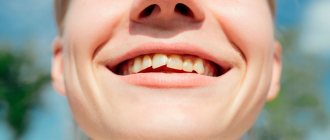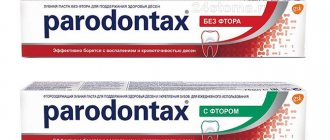What to do if teeth do not erupt “on time”?
Nothing to do. As stated earlier, the timing is quite relative and not strict data. There is such a thing as the individual characteristics of a child. Plus neonatal indicators, physical constitution, etc. Thus, the timing of the appearance of teeth in your child is normal for him. The same applies to permanent teeth.
The later the teeth appear, the healthier they will be?
Is not a fact. The timing of teething does not affect their “quality”.
What sedatives can be used during teething? Do they influence the process itself?
No, such drugs do not affect the process of teeth formation and, as a rule, have no side effects. For children with allergies, there is a sedative called Doctor Baby that does not contain lidocaine. Almost all gels contain lidocaine and inert fillers (cooling menthol, astringents and flavoring additives). You can use Dentinox, Kalgel (be careful with diathesis, because it is sweet), Kamistad (very effective, but you need to know when to stop), Mundizal, Cholisal, Solcoseryl dental paste (especially good in the presence of wounds or ulcers).
How often should such drugs be used?
Soothing gels are not antibiotics and do not need to be used according to a specific regimen. If the child is in pain, apply it, but if everything is calm, don’t. But it’s better not to use it more than 3-4 times a day and for longer than 3 days in a row.
How teeth are cut
Teething is a complex process, because at this time tissues are formed, tooth roots grow, and gums are rebuilt. Moreover, teeth begin to form during pregnancy, starting from the 6th week. Around this time, calcium begins to be deposited in the tissues of future teeth.
Next comes the fun part – teething. It is considered normal if teeth begin to cut between 4 and 7 months. But every body is unique, so everyone cuts their teeth differently. It depends on many things, for example:
- From genetics. Often the age at which a child begins to cut teeth depends on when his relatives - mom, dad, grandparents - started cutting teeth.
- From nutrition. If your baby doesn't have enough vitamins and minerals, such as vitamin C or calcium, his teeth will start cutting later.
- From the course of pregnancy. If there was fetal toxicosis during pregnancy, this will also slow down the appearance of teeth.
And normally, teeth are cut in pairs, that is, the lower central incisors appear first, then the upper central incisors, the upper lateral incisors - the lower lateral incisors, the upper first molars - the lower first molars, etc. But even if the order is disrupted, this does not always mean any illness or serious violation.
Is it possible to speed up teething?
Medication - no. But massaging your gums won't hurt at all. Using a clean finger, gently and gently massage your baby's gums. The baby will feel better, and the tooth will cut through faster. Just do not press hard so as not to injure the gums. You can give your child a cool spoon or pacifier to hold in his mouth. Try buying special teethers with liquid. They are placed in the refrigerator for a while, and then given to the child to chew on. All these methods are good in moderation, do not overdo it.
Can bad breath occur during teething and what is the cause?
The process of teething is associated with partial decomposition (lysis) of the mucous membrane under the action of salivary enzymes. We all notice that the amount of saliva increases sharply during this period. In this case, indeed, indicators such as viscosity, color and smell of saliva may change. Another factor is the presence of weak antibacterial substances in saliva, which are designed to prevent infection of the wound when a tooth cuts through the gum. A certain amount of blood also enters the oral cavity. When it decomposes, a sour (metallic) odor may appear.
A sharp increase in temperature during teething. What to do?
Teething does not cause a temperature jump to 39-40 degrees. Only a slight increase is possible, which is normal. Be careful: teething should not cause high fever, diarrhea, vomiting, complete loss of appetite, cramps or choking. If you have such symptoms, even if you attribute it to your teeth, consult a doctor. It is also not recommended to use antipyretics and painkillers without consulting him.
What is the difference between an increase in temperature due to teething and an increase due to other reasons? How long can the elevated temperature last in the first case?
It all depends on the individual characteristics of the child. Basically, hyperthermia and diarrhea are only secondary signs of the teething process, which in itself is a serious physiological turning point for a small organism. Fever is, rather, a reaction to inflammation of the oral mucosa. After all, at the site where the tooth exits, irritation forms, often a wound that can become infected. Thus, hyperthermia is caused not by the mechanism of tooth formation itself, but by side effects. After all, the eruption of permanent teeth, despite the similarity of histological and physiological changes, causes symptoms of colds and diarrhea extremely rarely. And it is quite simple to explain their appearance in children: changes in diet and diet, constant foreign objects in the mouth, microflora disturbance, weakened immunity in the nasopharynx. So, if high fever and loose stools continue for more than 72 hours, then teething really has nothing to do with it.
Ways to relieve teething pain
How can you help your baby cope with teething?
Teething is a difficult time for both children and parents. Most often, children become excitable, capricious, and irritable. Additionally, there are other signs of teething such as increased drooling or drooling. There is no need to worry too much as there are several ways that can help reduce discomfort and pain.
What is teething?
When teething occurs in babies and children, the growing teeth begin to penetrate the gum tissue that hides them and come out. Some children experience more severe pain, others less. Here are some signs and symptoms that can tell you your baby is starting to teethe:
- The gums in the area where the tooth is expected to erupt become inflamed and swollen.
- Your baby's cheek on the teething side may become red and hot.
- Children may constantly rub the ear on the teething side.
- The child begins to chew everything that comes to hand.
- Salivation increases, which can result in irritation on the chin.
- The child becomes irritable and shows other signs of discomfort, such as restless sleep and refusal to eat.
- During this time, children's temperature may periodically rise slightly.
What is the average duration of teething in children?
Typically, the first tooth appears between 6 months and one year of age.
A baby is born with all 20 baby teeth already under the gum - just waiting to emerge. And there is a clear pattern or order of teething. The front teeth (incisors) usually erupt first, and all subsequent teeth, upper and lower, appear one after another. The first molars at the end of the gums begin to appear around 12–15 months of age, while the canines usually erupt by the age of one and a half years. All baby teeth usually appear by age three.
How to soothe teething pain:
There are several options for helping your baby teething to make this difficult period of his life more comfortable:
Chew toys
You can purchase special chewing rings in a wide variety of shapes and materials designed for a child during this period. These rings help to significantly reduce the child’s discomfort and help the tooth appear as quickly as possible.
You can also use chewing toys (made from special soft fabric) and various nipples for a baby bottle.
Proper nutrition
Cool water is the best option during teething, especially if your baby drinks from a special sippy cup. Drinking a chilled drink will somewhat soothe irritated and inflamed gums in the same way as drinking fruit purees or drinking yoghurt in a cool form.
Creative distraction or special game
Try to distract your child with some creative activities from discomfort and pain in the mouth. Cuddle him, play with him, prepare a warm bath for him. If your baby is still breastfed, feed him.
Gum massage
If you lightly massage your baby's gums with a clean finger, the pain will calm down a little. This may also help the tooth erupt.
Skin protection
You can use baby cream to reduce chin irritation. It is also necessary to change the child’s bedding in a timely manner.
Dental gels
Such drugs are presented by many pharmaceutical companies. They may contain local anesthetic components. Gels give temporary results because they are easily washed off with saliva.
Children's dental gels contain components with a high safety profile, some of which can be used as early as 5 months of age. It is recommended to follow the instructions for use and use only drugs that are registered for children of the appropriate age.
Fever and pain
You should see a doctor if your baby has a high fever or is unusually uncomfortable or painful, which indicates something more serious than teething symptoms.
Finally, don't forget that all children teeth naturally, so don't take your child's painful illnesses too seriously during this difficult time for him (and his family).
Teething in infants
Possible characteristics of teeth in children at the teething stage. Stay up to date.
The expansion of the spaces between the teeth is caused by the growth of the jaws. During the transition from baby teeth to permanent teeth, it is considered a normal condition. A wide gap between the upper anterior incisors is usually associated with a deep-lying maxillary frenulum. An orthodontist should observe and treat such a gap between the teeth;
- a blackish edging on the neck of the tooth can form when taking soluble iron supplements, as well as during a chronic inflammatory process (precipitation of bacteria from the leptotrichium group);
- yellowish-brown staining of teeth may be associated with the use of antibiotics - by the mother in the 2nd half of pregnancy or by the child himself during the formation of teeth;
- yellowish-greenish coloring is caused by severe disturbances in bilirubin metabolism, hemolytic conditions (destruction of red blood cells);
- reddish staining of tooth enamel is characteristic of a disease called porphyria - a congenital disorder of the metabolism of porphyrin pigment;
- malocclusions are formed by the uneven growth of the child’s jaws, as well as prolonged sucking of the nipples;
- Anomalies in the location of teeth occur for a number of reasons: trauma, congenital disorders of connective tissue metabolism, constitutional reasons (small jaw size), tumors of the alveolar process of the jaw.
- the absence of teeth before one year of age is extremely rarely associated with edentia (lack of tooth buds), which can be checked using radiovisiography as prescribed by a pediatric dentist.
If teeth erupt on time and in a certain order, this indicates the normal development of the child’s body. After all, this physiological process is in direct connection with the general health of the baby. Some atypical cases may indirectly indicate the presence of pathology. But only a special examination of the child can confirm or refute the assumptions made. The reasons must be identified and analyzed by a specialist.
When to sound the alarm
In those places where teeth erupt, many biologically active substances are released, for example, histamine, leukotrienes, prostaglandins, etc. They cause the symptoms that every parent is familiar with:
- Temperature increase. Normally, when teething, the temperature should be low-grade, that is, no more than 38 degrees;
- Swelling, pain and redness of the gums.
This is a normal baby reaction to teething. As a rule, the baby refuses to eat, but at the same time pulls toys into his mouth to chew on them. Due to the fact that the child constantly chews something, the nerves of the gums are irritated and a lot of saliva is released, and since the child does not yet know how to control saliva, it flows out of the mouth. The child also becomes more excitable than usual - he sleeps less, is constantly capricious, and becomes irritable.
Life hack: to help your child and relieve tooth pain, buy a special teething toy. This toy can be filled with water and placed in the refrigerator. When the baby chews on it, the toy will cool the inflamed gums and thereby partially relieve the pain.
But there are symptoms that parents often confuse with a normal reaction to the appearance of teeth:
— Digestive disorders – diarrhea, vomiting, loose stools;
— Temperature above 38-39 degrees, which does not subside for several days;
- Cough, rash, swelling.
These symptoms indicate that there is an infection in the child’s body that needs to be treated.
Eruption of molars
When should I expect my molars to erupt? The replacement of baby teeth begins at the age of five and continues until the age of fourteen. By the time the shift is completed, the child will have erupted all 24 teeth, except the wisdom teeth. This is a separate topic for study that parents can refer to later.
The first to change are the incisors on the lower jaw. Then the “sixes” are cut, and only after that the molar upper central incisors grow. By the age of 8, the upper lateral incisors erupt. After this, at 9–10 years old, the upper and lower “fours” change. At 10–11 years old, “fives” change, at 12–13 years old, fangs, and at 14–15 years old “sevens” erupt.
When talking about molars in children, you need to understand that these teeth will remain for life. That is why it is necessary to create favorable conditions for the formation of a new dentition. This is done by taking care of baby teeth and monitoring the eruption of each new molar.
Timely correction of curvature, mineralization, treatment of caries, sealing of fissures - procedures thanks to which the child does not have to hide his teeth while smiling and wear braces for several years.
Remember: each period of teeth change is characterized by its own characteristics and sensations. For example, before this process begins, the child may experience discomfort and pain due to jaw growth. Another example is the eruption of “sixes”, which grow by the age of 6 and are immediately indigenous. Parents should be aware of this so as not to mistake these teeth for baby teeth.
The process of formation of molars will take place without pain and problems if the child is regularly examined by a dentist. It will correct imperfections in time and help teeth grow straight, strong and beautiful.
Possible complications of molars
The main danger in the process of changing teeth will be insufficient oral hygiene. The child should brush his teeth regularly and properly and eat well. He should know that after eating sweet food he must brush his teeth or at least rinse his mouth.
A common problem after teething is the potentially dangerous pigmentation of fissures - depressions on the chewing surface of the teeth (not counting the canines and incisors). The fact is that the process of mineralization and formation of a strong tooth structure takes about 3 years after eruption. During this period, teeth are vulnerable and, with insufficient hygiene, can become pigmented and subsequently become infected with caries.
Let us remind you: if there were problems with your baby teeth, they will most likely affect the new molars. Also, possible complications of molars are associated with infections that can get inside the gums after baby teeth fall out. Therefore, hygiene during this period of the baby’s life must be strictly monitored.









